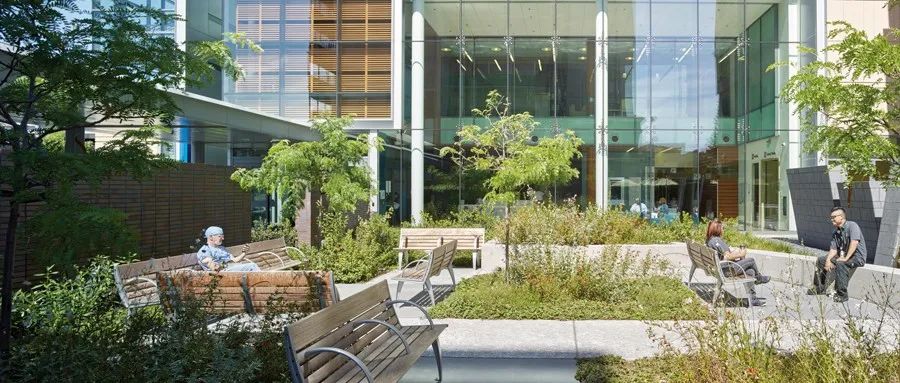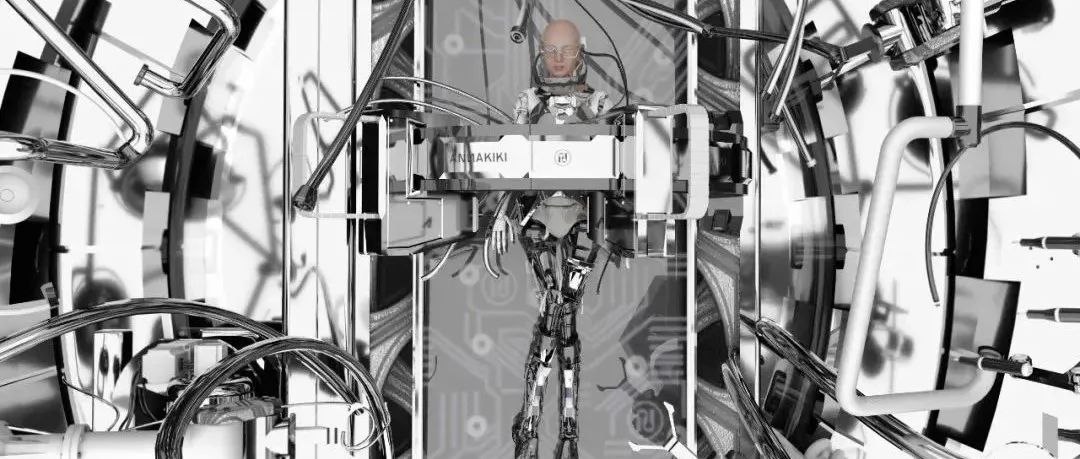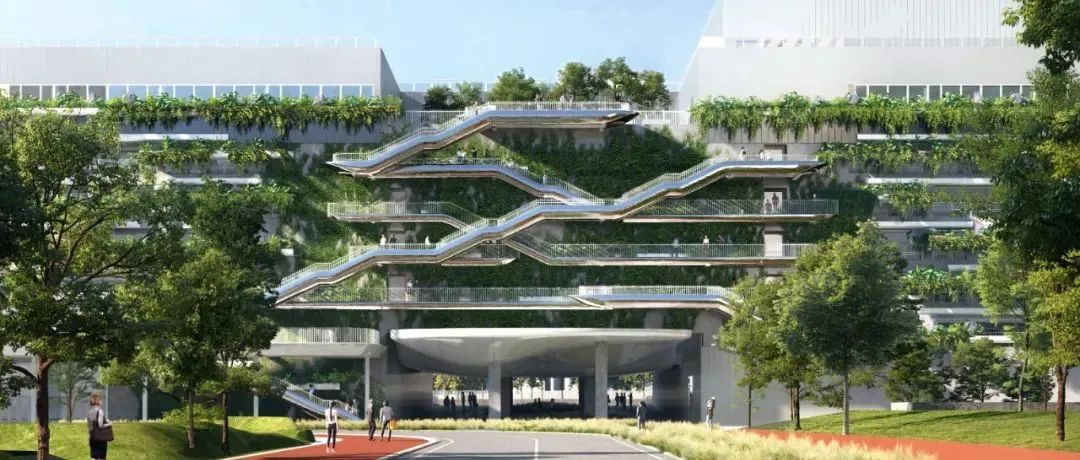通过这场疫情,大家了解到了医护人员面临的严重职业压力。创造一个有助于恢复良好身心状态的医院环境可以缓解医护人员的焦虑和倦怠感,同时也能提高他们照顾患者的能力。
美国犹他大学医院2021年度的一项研究报告称,在治疗新冠患者的所有医生、护士和急救人员中,有一半以上的人容易受到抑郁症、失眠、焦虑和药物滥用等心理健康问题的影响。这与自然灾害和恐怖袭击后医护人员的发病率相当。
图1:美国加利福尼亚凯撒红木城医疗中心 | Image 1: Kaiser Permanente Redwood City Hospital
图2 & 3:美国纽约长老会医院大卫·H·科赫中心 | Image 2 & 3: New York Presbyterian Hospital David H. Koch Center
设计师可以帮助卫生系统和医疗组织采取整体性方法为其员工设计“恢复空间”。最好的方法是将医院建筑的各个方面都考虑在内,以此作为促进员工身心健康的机会。
一线医护人员自然会将患者的需求放在第一位。然而,在疫情最严重的时候,他们照顾自己的时间比以往任何时候都要少。但即使是一些简单的融入健康设计的策略,也可以给疲惫、时间紧张的医护人员提供一些喘息的机会。
与自然的联系
我们知道大自然对患者的疗愈产生的影响。亲生物设计元素也可以为员工在心理健康方面提供益处。即使短暂地接触植物、水、微风、自然图案和基于自然的图像,也可以帮助医护人员放松和重新集中注意力。除病房外,还可以将亲生物元素纳入走廊和护士站等人流密集的区域。
美国纽约长老会医院大卫·H·科赫中心 | New York Presbyterian Hospital David H. Koch Center
人们与生俱来就有一种与大自然互动的渴望。提供户外空间,让员工晒晒太阳,呼吸新鲜空气,然后放松,这些都可以带来有据可查的益处。
图1:新加坡黄廷芳综合医院 | Image 1: Ng Teng Fong General Hospital
图2 & 3:美国斯坦福大学医学院学术医学中心 | Image 2 & 3: Stanford University School of Medicine Center for Academic Medicine
明亮的灯光
光线影响人们的生理节律,从而影响我们的睡眠模式和免疫系统。即使在最好的条件下,大多数医护人员也无法获得其昼夜节律所需的光线量和类型。
图1:美国纽约长老会医院大卫·H·科赫中心 | Image 1: New York Presbyterian Hospital David H. Koch Center
图2:新加坡伊丽莎白诺维娜医院 | Image 2: Singapore Mount Elizabeth Novena Hospital
虽然病房的设计标准要求包括照明控制与能够欣赏到窗外景色的视野等因素,但员工空间并非总是如此。照明系统可以通过在一天中改变色温来支持昼夜节律。
美国洛杉矶凯撒医疗Baldwin Hills–Crenshaw医疗中心 | Kaiser Permanente Baldwin Hills–Crenshaw Medical Offices
对于疲惫的员工来说,接触自然光可以产生和喝一杯咖啡一样的效果。医疗工作者通常在日出前到达医院,日落后离开或上夜班。所以提供可调光照明是维护健康的一个特别重要的部分。
休息室
为医护人员提供专门的休息室可以是解决方案的一部分。
美国纽约长老会医院大卫·H·科赫中心 | New York Presbyterian Hospital David H. Koch Center
这些空间应该安排在便于出入的位置,设计需要融入能够吸引人们感官的因素。闲适宁静的图形和郁郁葱葱的植物,舒缓的气味和音乐,舒适的家具,以及健康的食物和饮料都可以缓解压力。
图1:美国印第安纳大学医学院Eskenazi医院 | Image 1: Sidney & Lois Eskenazi Hospital
图2:加拿大多伦多汉伯河医院 | Image 2: Humber River Hospital
为咨询或教牧关怀等支持服务提供额外的安静空间也很重要。休息和安静空间应在声学上与工作环境隔开,使人们有机会远离背景噪音,并脱离工作环境。
政策和文化
休息室和户外露台等空间只有在机构鼓励员工使用时才能体现它的价值。虽然精心设计的建筑环境设计可以缓解医护人员面临的一些心理健康问题,但这只是创建一个鼓励并理解员工的组织文化的一部分。
美国纽约长老会医院大卫·H·科赫中心 | New York Presbyterian Hospital David H. Koch Center
Respite for the Weary Healthcare Worker
The pandemic has shined a light on the severe occupational stress facing healthcare workers. Creating restorative hospital environments can ease their feelings of anxiety and burnout while improving their ability to care for patients.
A 2021 University of Utah Health study reported that more than half of all doctors, nurses and emergency responders treating COVID-19 patients were vulnerable to mental health issues ranging from depression and insomnia to anxiety and substance abuse. The risk was comparable to rates observed in healthcare workers following natural disasters and terrorist attacks.
美国纽约长老会医院大卫·H·科赫中心 | New York Presbyterian Hospital David H. Koch Center
Designers can help health systems and healthcare organizations take a holistic approach to designing restorative spaces for their people. The best approach is to think about every aspect of a hospital building as an opportunity to boost staff health and wellness.
Frontline healthcare workers will, by nature, always will put patient welfare in front of their own. During the height of the pandemic, though, they had even less time than ever to take care of themselves. But even a few simple wellness-infused design strategies can give frazzled, time-crunched healthcare workers a few moments of respite.
Natural Connections
By now we’re all well-versed in the healing power of nature for patients. We need to remember that biophilic design elements also can offer mental health benefits for staff. Experiencing plants, water, breezes, natural patterns and nature-based images—even for short periods of time—can help healthcare workers relax and refocus. In addition to patient rooms, biophilic elements can be incorporated into high-traffic areas like hallways and nurses’ stations.
美国纽约长老会医院大卫·H·科赫中心 | New York Presbyterian Hospital David H. Koch Center
We all have an innate desire to experience direct connections with nature. Providing outdoor spaces where staff can soak up some sun, breathe in the fresh air and just “be” brings well-documented wellness benefits.
新加坡黄廷芳综合医院 | Ng Teng Fong General Hospital
Shining Light
Light affects people’s circadian rhythms, which impacts our sleep patterns and immune systems. Even in the best circumstances, most healthcare workers don’t get the amount and type of light required to fully stimulate their circadian rhythms.
美国纽约长老会医院大卫·H·科赫中心 | New York Presbyterian Hospital David H. Koch Center
Though it’s standard for patient rooms to include lighting controls and access to outdoor views and daylight, that’s not always the case for staff spaces. Lighting systems can support circadian rhythms by changing color temperature over the course of the day.
For weary staff, experiencing a burst of light can have the same effect as drinking a cup of coffee. Providing access to dimmable lighting is an especially vital part of maintaining the well-being of healthcare workers who regularly arrive at the hospital before sunrise, leave after sunset or work the night shift.
Respite Rooms
Respite rooms—dedicated spaces for healthcare workers to recharge—can be part of the solutions.
美国纽约长老会医院大卫·H·科赫中心 | New York Presbyterian Hospital David H. Koch Center
These spaces should be strategically located for easy access and engage people’s senses. Peaceful graphics and lush plants, calming scents and music, comfortable furniture and access to healthy food and drinks all can provide relief.
Providing additional quiet spaces for support services like counseling or pastoral care also is important. Respite and quiet spaces should be acoustically separated from the work environment, giving people a break from the background noises and an opportunity to disconnect from their work.
Supportive Policies and Culture
Respite rooms and outdoor patios are only valuable if institutions encourage their people to use them. While thoughtful design of the built environment can ease some of the mental health issues facing clinicians, it is only one aspect of an organization’s efforts to create a supportive, empathetic culture.
相关阅读 Project Story ++
本文来自微信公众号“HOK贺克”(ID:hok_ap)。大作社经授权转载,该文观点仅代表作者本人,大作社平台仅提供信息存储空间服务。












